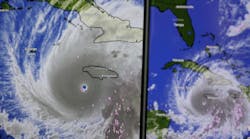About the author: Gina Carolan is chief operating officer of CULTEC Inc. Carolan can be reached at 203.775.4416 or by e-mail at [email protected].
Roma Court, a 55,000-sq-ft development located in Palm Coast, Fla., is expected to be completed in 2008. Roma Court will offer retail, restaurant and office space surrounding an interior courtyard featuring Italian Renaissance architecture, grand stairways, elevators, fountains, statues and seating areas.
From a prospective tenant’s standpoint, though, one of the more attractive features will be the development’s 275 available parking spaces. Roma Court’s 187 above-ground spaces and 88 underground spaces goes 25 percent beyond the minimum recommended number of parking spaces, according to standards established by the Urban Land Institute and the International Council of Shopping Centers.
As with all new construction, storm water management needed to be addressed in the development’s design, which required a storage capacity of 55,800 cu ft.
Getting Down to Business
The high cost of land and the Roma Court developer’s wish to offer tenants ample parking made it undesirable to use older best management practices (BMPs) such as ponds and swales. In order to accommodate the needs of the project, Jason Kellogg of CPH Engineers, Palm Coast, Fla., turned his attention to underground storage systems.
“Land here has gotten very expensive,” Kellogg said, “and we really wanted to provide a beautiful and inviting location with plenty of parking."
Kellogg turned to Connecticut-based CULTEC Inc., with whom he had worked for several years. “They helped us design the system and come up with a design that was more than adequate for our storage needs,” he said.
While underground storage may have been the best choice from a land-use perspective, it posed some excavation issues since the location featured a high water table and sat very close to wetlands.
“The soil conditions were very mucky, and there was very limited space with which to work,” said CULTEC’s Ted McCarter. “The storage requirements were reasonably high, while the water table limited how far down the contractor could go, and there was only so much area we could dig. We had to be somewhat creative, but at the end of the day, we had a system that more than did the job, and it ended up being a very cost-effective installation for the developer.”
Mike Buchberg represents Marsh Moore Co., the local manufacturer’s representative for CULTEC. “There were really three reasons why we were able to get this project,” he said. “First, CULTEC offers such a wide range of chamber sizes, so we were able to choose units that offered a lower profile so we wouldn’t have to go down as far. Second, the header system that tied all the fields into one was significantly less expensive than typical pipe systems. Finally, the system-compatible Stormfilter 400 filtration units allow the developer to inexpensively meet the local maintenance requirements.”
Piece by Piece
To meet the requirements of this application, Kellogg worked with CULTEC technical assistants to design a system featuring three separate detention beds tied together via a header system, essentially forming one large bed over the site’s unique footprint. The installed system had a storage capacity of more than 64,000 cu ft, or 10 percent more than what was required.
The system design incorporated more than 1,800 Recharger 180HD storm water chambers, an HVLV 180 header system to create the manifold system, four Stormfilter 400 units and stone backfill. The chambers, which feature a patented overlapping and interlocking rib design, can store approximately 30 cu ft of storm water in each unit, per the installed design. Less than 21 in. high, the chambers offered the maximum storage capacity available for the given soil conditions.
The HVLV 180 header system includes end and middle chambers ranging between 5 and 5.6 ft long, plus shorter feed connectors to tie the system together. Installation is enabled by field-cutting openings in the designated area of the chamber’s side wall. More than 250 header units were utilized in this application to comprise the manifold system.
To meet local maintenance requirements and prevent silt and other particulate matter from entering and clogging the system, the four Stormfilter 400 units were installed. This secondary inline filter system removes many of the smaller particles not eliminated via conventional structures during the pretreatment process.
Much of the fill utilized in this application was actually recycled material. “Virgin gravel is very expensive around here, so we were able to both save money and take a very green approach by using recycled concrete,” McCarter said. “We used more than 150 dump truck loads of recycled concrete here, which might otherwise have ended up in a landfill somewhere.”
Installation at Roma Court began in November 2007 and was completed by year’s end. “It only took a contractor and two other workers to put the entire system in,” McCarter said. “This system is very complex, yet all the contractor needed to guide him through the installation was one preconstruction meeting and literature.”
Saving Space & Money
Slated to open by summer 2008, the Roma Court shopping center is a prime example to support the benefits of an underground storage system. The installed CULTEC system provided engineers with a cost-effective BMP that ultimately exceeded the project’s storage capacity requirements.
More significantly from the developer’s standpoint, having the system underground maximized use of the property and available parking, which should make the new center appealing to prospective tenants.
Download: Here

